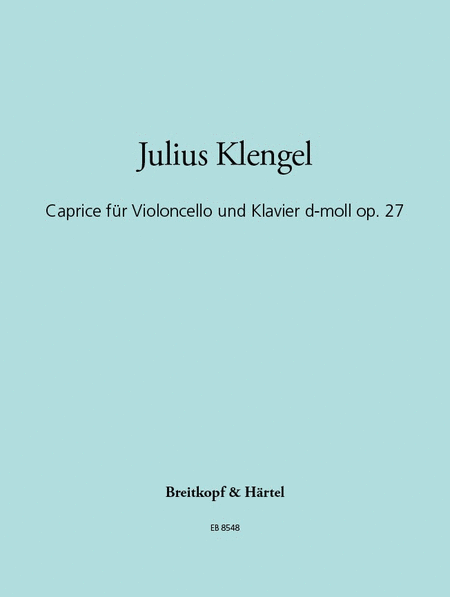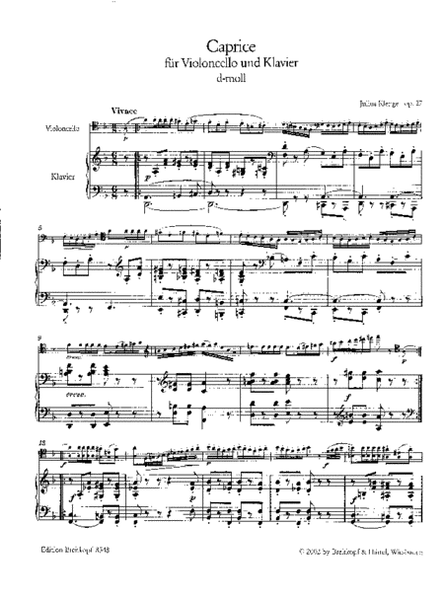Caprice in D minor Op. 27
-
Ships in 3 to 4 weeks
Details
Description
SKU: BR.EB-8548
Composed by Julius Klengel. Solo instruments; Softcover. Edition Breitkopf. Romantic; Late-romantic. Score. 16 pages. Breitkopf and Haertel #EB 8548. Published by Breitkopf and Haertel (BR.EB-8548).ISBN 9790004181317. 9 x 12 inches.
The Leipzig cellist Julius Klengel (1859-1933) devoted himself passionately and wholeheartedly to bis instrument for over half a century. Throughout bis life, he was active in the concert hall as a performing artist. His artistry was admired far beyond the borders of bis native city, at the earliest since he joined the renowned Gewandhaus Orchestra in Leipzig at the age of 15, and at the latest since bis debut as a soloist in the Gewandhaus's 1880/81 season. Klengel was also a composer, who introduced himself as such to the Leipzig public at the age of 21 with bis own Concerto in A minor Op. 4. Without yielding to excessive productivity, he regularly wrote works that generally bad some connection with bis own instrument. Klengel's work catalogue contains four concertos for solo cello and orchestra, two double concertos (one of them with violin), two string quartets, several piano trios and, above all, a great many solo pieces and studies for cello with and without piano. The works for several violoncelli, which include the Hymnus Op. 57 for 12 celli (EB 6846/47) are of considerable significance and are still viewed to this day as much more than curios. Klengel found in Leipzig's Breitkopf & Hartel a large, internationally active publisher who printed and distributed all of bis works. The extent of Klengel's activity is not comprehensively outlined, however, without a mention of bis pedagogical work. Parallel to bis work as a performer and composer, Klengel was also a teacher who was appointed professor at the Leipzig Conservatory. In addition to writing instructional methods and cello etudes, he also arranged and edited - with the intent of using these pieces in bis teaching - a number of cello works from the Baroque, Classical and Romantic eras, including Bach's suites and Schumann's Cello Concerto. The Caprice in D minor Op. 27 for violoncello and piano reflects the talent of a virtuoso performer who was able to write bis own bravura pieces. The work is laid out very clearly in an A-B-A-B-A form. The Vivace (and Vivacissimo in the closing section) does full justice to the title of the piece. However, unlike many pieces from the second half of the 19th century designed for soloists, this one never neglects the accompanist. The pianist always has rewarding material and occasionally makes genuinely contrapuntal contributions to the activity. Quite remarkable is the closing section, which shifts from D minor to D major. As mentioned above, Klenge! whips the tempo on to a Vivacissimo, but keeps a tight rein on the dynamics, holding them almost consistently in pianissimo sempre for 23 measures. The piece fades away on the lonely, lowest D of the two instruments. Julius Klengel's Caprice in D minor Op. 27 for violoncello and piano bad long been out of print. This new edition is based on the first edition of 1891. The musical text was submitted to a comprehensive revision for this reprinting. All errors were eliminated and measure numbers supplied for easier orientation. Frank Reinisch, Wiesbaden, Spring 2002.


 Share
Share